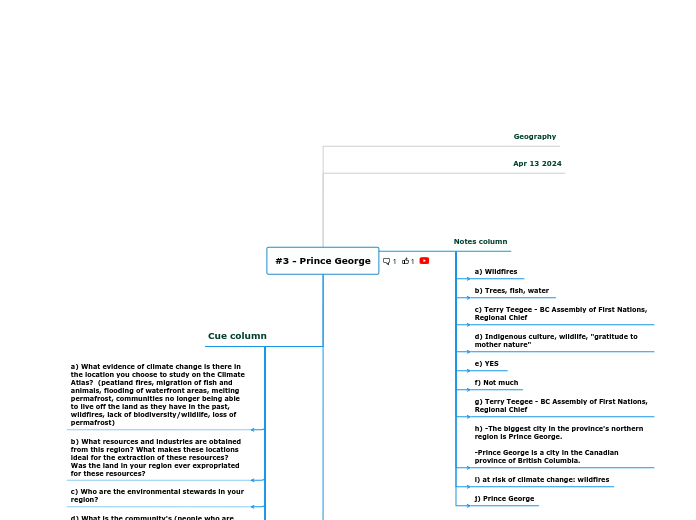#3 - Prince George
Geography
Apr 13 2024
Notes column
a) Wildfires
b) Trees, fish, water
c) Terry Teegee - BC Assembly of First Nations, Regional Chief
d) Indigenous culture, wildlife, "gratitude to mother nature"
e) YES
f) Not much
g) Terry Teegee - BC Assembly of First Nations, Regional Chief
h) -The biggest city in the province's northern region is Prince George.
-Prince George is a city in the Canadian province of British Columbia.
i) at risk of climate change: wildfires
j) Prince George
Summary
A significant evidence of climate change in Prince George are forest wildfires.
Wildfires are a threat to the indigenous community and wildlife.
Prince George is a city in British Columbia.
Prince George is abundant in resources such as trees, fish, and water.
Cue column
a) What evidence of climate change is there in the location you choose to study on the Climate Atlas? (peatland fires, migration of fish and animals, flooding of waterfront areas, melting permafrost, communities no longer being able to live off the land as they have in the past, wildfires, lack of biodiversity/wildlife, loss of permafrost)
b) What resources and industries are obtained from this region? What makes these locations ideal for the extraction of these resources? Was the land in your region ever expropriated for these resources?
c) Who are the environmental stewards in your region?
d) What is the community's (people who are currently living on the land) relationship with the land they live on?
e) Does the area have clean drinking water, food and energy security?
f) Has the community been in the media lately?
g) Who are the change makers/activists in the community? What activism have they participated in? How long have they been working on creating positive change?
h) What is where?
i) Why there?
j) Why care?
